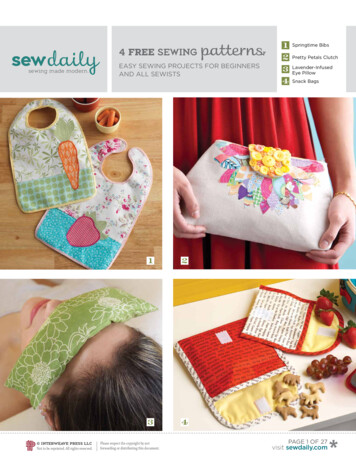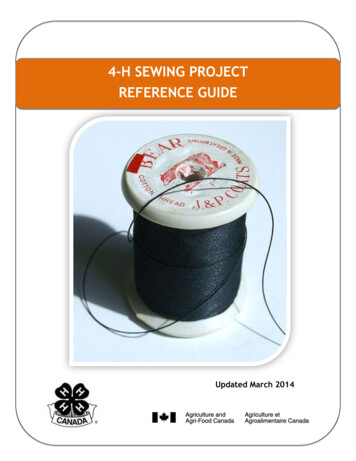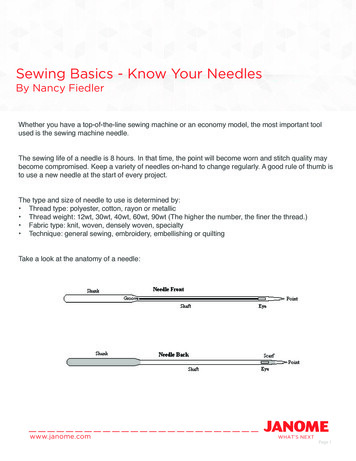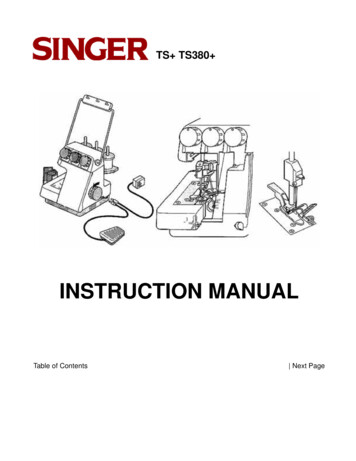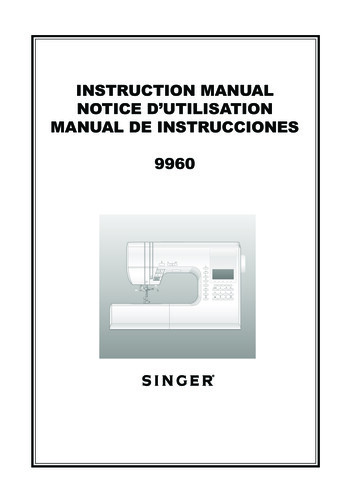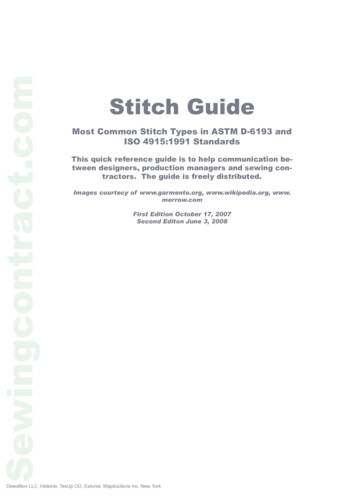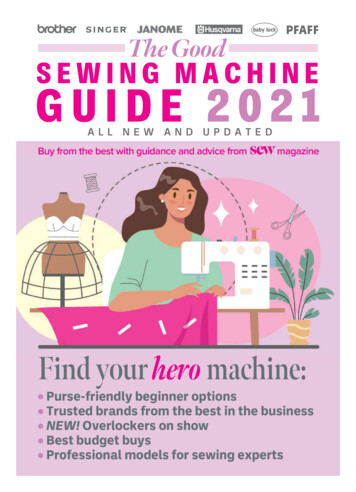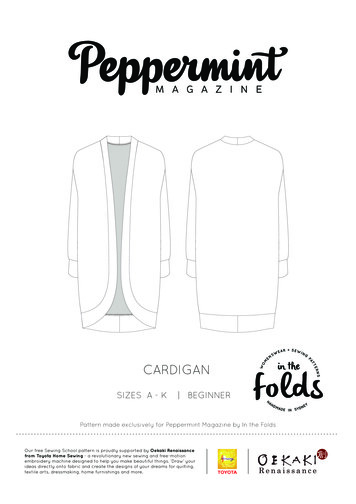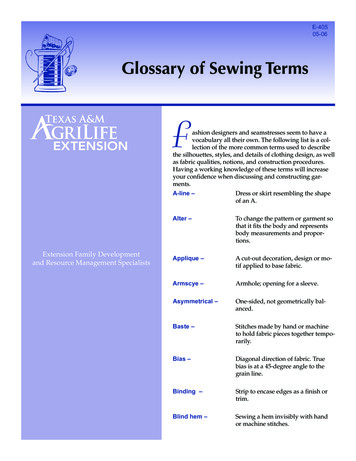
Transcription
E-40505-06Glossary of Sewing TermsFashion designers and seamstresses seem to have avocabulary all their own. The following list is a collection of the more common terms used to describethe silhouettes, styles, and details of clothing design, as wellas fabric qualities, notions, and construction procedures.Having a working knowledge of these terms will increaseyour confidence when discussing and constructing garments.Extension Family Developmentand Resource Management SpecialistsA-line –Dress or skirt resembling the shapeof an A.Alter –To change the pattern or garment sothat it fits the body and representsbody measurements and proportions.Applique –A cut-out decoration, design or motif applied to base fabric.Armscye –Armhole; opening for a sleeve.Asymmetrical –One-sided, not geometrically balanced.Baste –Stitches made by hand or machineto hold fabric pieces together temporarily.Bias –Diagonal direction of fabric. Truebias is at a 45-degree angle to thegrain line.Binding –Strip to encase edges as a finish ortrim.Blind hem –Sewing a hem invisibly with handor machine stitches.
2.Blouson –Bloused effect of fullness gathered in at and falling over aseam, typically the bodice overa skirt.Dart –A tuck in the fabric that helpsin fitting the garment over thebody curve.Bodice –Portion of garment above thewaist.Dolman –Sleeve set into a deep armholeso as to resemble a kimonosleeve.Bolt –Unit in which fabric is packagedand sold by the manufacturer.Usually contains 12 to 20 yards.Double-breasted –Front closing that overlapsenough to allow two rows ofbuttons.Boning –Flexible strips used to stiffenseams or edges.Drum lining –Lining not sewn into garmentseams.Casing –A folded-over edge of garmentor area through which elastic orribbon is threaded.Ease –Chevron –V-shaped stripes.Clean finish –A method for finishing theraw edges of pockets, hems orseams.The even distribution of slightfullness when one section ofa seam is joined to a slightlyshorter section without forminggathers or tucks. Used to shapeset-in sleeves, princess seams,etc.Edge stitching –Stitching placed 1 16 inch fromthe edge; may be stitchingdetail, such as topstitching orstitching done to finish the outeredge of a seam or facing edge.Empire –High waistline bodice with aloose, straight skirt.Enclosed seam –A seam allowance along a facededge that is stitched and turnedto form an enclosed seam between two layers of fabric.Eyelet –Small, round, finished hole in agarment or fabric.Fabric hand –The way a fabric feels anddrapes; its flexibility, smoothness and softness.Clip –A cut in fabric to allow ease oncurves or corners. Also used toindicate notches in pattern.Closure –That which opens or closes agarment (buttons, snaps, etc.,or the area on which they areplaced).Colorfast –Fabric that will not fade or runduring cleaning or laundering.Contrasting –Opposing; showing off differences of color, fabric, shading,etc.Crease –A line made by folding the fabric and pressing the fold on thisspecified line.
. 3Facing –To finish an edge by applyinga fitted piece of fabric, binding,etc. Also the right side of thefabric.Fell stitch –Neat, tiny, vertical stitches usedin tailoring.Finger press –Pressing a small area by creasing with the fingers.Finish –Any means of completing a rawgarment edge to keep it fromraveling, rolling or fraying.Flap –Shaped garment piece attachedby only one edge, such as a flappocket.Flare –Portion of garment that spreadsout or widens.Fly –Fabric used as lap to conceal anopening in a garment.Fold line –The line where fabric is folded,usually vertically, when cuttingout a garment. It is common forthe center front of a garment tobe placed on a fold line.Fusible web –A web-like adhesive that meltswhen you apply heat and moisture.Gather –To draw up fabric fullness on aline of stitching.Give –The amount of stretch on fabricthat yields to pressure withouttearing or breaking.Gore –Tapered section of a garment;wider at the lower edge.Grade –To reduce the bulk of enclosedseams by trimming the individual seam allowances differentwidths, clipping inward curvesand corners, notching convexcurves, and trimming away excess fabric at outward corners.Grosgrain –Silk fabric or ribbon havingheavy crosswise ribs.Gusset –A fabric piece inserted at the underarm to give ease in the sleevearea.Hem –The finished portion on skirts,jackets and sleeves held in placewith a hemming stitch.Interfacing –A carefully selected fabricplaced between the garmentand the facing fabric for addedbody, to give support, and tomaintain shape.Join –A term used in pattern directions that usually means tostitch together the pieces referred to using normal seamallowances and regular stitches.Keyhole –Rounded neckline with an inverted, wedge-shaped openingat front or back.Lap –To fold or extend a garmentpiece over another.Lapels –Part of a garment that turnsback, especially the front neckline fold of a jacket.Layout –Cutting chart on instructionguide sheet showing the placement of pattern pieces.
4.Line –Marking –Style, outline or effect given bythe cut and construction of agarment.Transfer of construction symbols from paper pattern tofabric.Match –To bring notches or otherconstruction markings on twopieces together.Miter –To form a diagonal seam at asquare corner.Motif –Unit of design; used as decoration or pattern.Nap –Soft surface with fibers that liesmoothly in one direction.Notch –Cutting wedges from seam allowances of an outward curve.Also a pattern symbol transferred to fabric to indicate seaming.Notions –Pattern markings –Peplum –Items other than fabric or a pattern required to complete a garment, such as buttons, thread,zipper, etc.The symbols for constructionprinted on the pattern, such asfor darts, buttonholes, notches,dots or tucks. They are transferred from the pattern to thefabric by means of tailor’s tacks,notches, chalk, basting or temporary fabric markers.Small flounce or extension ofgarment around the hips, usually from the bodice.Pin basting –Pinning seams before stitching.Pinking –Cutting raw edges with pinkingor scalloping sheers to preventraveling.Pintuck –A narrow channel of fabricstitched together to form tuckdesign detail, used in frenchhand sewing.Pivot –Stitching around a corner byleaving the needle in the fabric,raising the presser foot, andturning the fabric in a new direction.Placket –Garment opening fastened withzipper, snaps or buttons. Finishapplied to sleeve opening withcuff.Pre-shrink –Washing/dry-cleaning fabricto allow for shrinkage of fabricbefore construction.Princess line –Garment fitted with seams instead of darts.Ravel –To fray.Raw edge –Unfinished edge of fabric.Right side –Finished side of fabric, outsideof garment.Rip –To remove stitches improperlyplaced; also tearing fabric alongthe straight grain.Roll –Desired curve and fold (commonly on a collar); shapingestablished by pressing, padstitching, etc.
. 5Seam –Two or more edges of fabricheld together by sewing. Seamshould be well constructed andappropriate for the fabric, typeof garment, and the location onthe garment.Silhouette –Outline or contour of a figure orgarment.Single-breasted –Center front closing withenough flap to allow one row ofbuttons.Seam allowance –Width of fabric beyond the seamline, not including the garmentarea.Slash –Cut taken in fabric to facilitateconstruction or turning of fabricat a point or corner.Seam binding –Ribbon-like tape used to finishedges.Slip stitch –Secure –Fasten permanently by means ofa knot, backstitching, etc.A hand stitch used to join twolayers of fabric from the rightside.Stay –Means of maintaining the shapeof a garment area, by using asmall piece of fabric or tape thatis sewn to an area of the garment to reinforce and secure aposition.Stitching inthe ditch –The technique of sewing astraight stitch inconspicuouslyin the seam well on the correctside of a previously stitchedseam. Used to complete waistbands, cuffs, collars, and frenchbias binding.Tack –Joining two garment layers withsmall, loose, hand stitches orthread loops.Tailoring –Construction technique requiring special hand sewing andpressing to mold fabric into afinished garment.Taper –Cutting or stitching at a slightdiagonal, generally to makegradually smaller.Template –A shape made of a stiff substance, such as freezer paper,usually the size of the finisheddesign. (i.e., pocket, appliqueshape or quilt pattern)Self fabric –Of the same material as the restof the garment.Selvage –Lengthwise finished edges onall woven fabrics. Running parallel to the lengthwise grain.Semi-fitted –Fitting to conform partly, butnot too closely, to the shape ofthe figure.Serger –A machine that overcasts andtrims an edge simultaneously.Shank –Link between button and fabricto allow for the thickness ofoverlapping fabric.Sheath –Close-fitting dress with astraight skirt.Shirtwaist –Dress with bodice details similar to a shirt.Shrinking –Constricting fabric with steamor water to eliminate excess in aspecific area. Also done to fabricbefore cutting out a garment toprevent further fabric shrinkage.
6.Tension –Amount of pull on thread orfabric during construction.Also the relationship of theneedle and bobbin thread andhow they interlock to form thesewing machine stitch, creating a balanced, looser or tighterstitch.Underlining –Lining joined in garment seamsthat is used to give shape orsupport.Understitching –Folding the entire seam allowance to the facing side or underside and then stitching on thecorrect side of the facing closeto the seam edge. This allowsthe seam to lie flat and keeps theseam edge from showing on thecorrect side of the garment.Thread count –Number of threads in 1 squareinch of fabric.Topstitching –Line of machine stitching parallel to a seam or edge, done fromthe right side of a garment.Vent –Faced or lined slash in a garment for ease.Trim –To cut away excess fabric.Welt –Strip of material stitched to aseam, border or edge.Trimming –Feature added to a garment forornamentation, such as braid orself fabric.Wrap-around –Garment or part of a garmentwrapped around a person, suchas a skirt.Turnover –A garment section, usually a collar or cuff, that folds back uponitself.Wrong side –The inside of a garment or backside of fabric.Twill tape –Firmly woven tape used for tailoring to reinforce and preventstretching.Yoke –Fitted portion of garment, usually at shoulders or hips, designedto support the rest of the garment hanging from it.This publication was adapted from “Garment Construction Terms” by Cynthia Klumpp,Master Clothing Volunteer Coordinator, Cooperative Extension Service, University of Arkansas.
Glossary of Sewing Terms E-405 05-06. ashion designers and seamstresses seem to have a vocabulary all their own. The following list is a col-lection of the more common terms used to describe the silhouettes, styles, and details of clothing design, as well a
